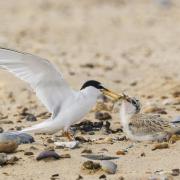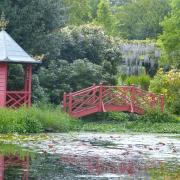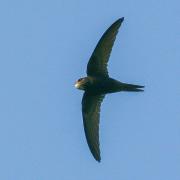RSPB Havergate Island is Suffolk’s only island and a haven for wildlife. RSPB warden Lyndsey Record has the enviable job of looking after it, as well as other RSPB reserves on the Suffolk coast. So what makes them so special?
As luck would have it, the much-anticipated day in January when I'm supposed to hop over to Havergate Island with RSPB warden Lyndsey Record is just about the windiest of the brand new year – too windy, it turns out, even for a short boat trip.
Instead, we agree to meet at her office at Snape. I'm happy with that; there will be better days for island-hopping and Havergate's not going anywhere. Well, actually it is, but more of that later.
Lyndsey's office is a discreet building, along a rutted road, a stone's throw from where the winding River Fromus joins the Alde. This is RSPB Snape Wetlands, a 202-acre wetland near Snape Maltings comprising the original Abbey Farm reserve and recently created Botany Marshes. It's not open to the public but is owned and managed by the RSPB as habitat for a wide variety of birds, mammals and invertebrates.

Between 2008 and 2014 the charity converted dry grassland into wetland and reedbeds, excavating ponds and pools, and adjusting water levels. Since that time, the reserve has attracted breeding bittern, marsh harrier and bearded tit, as well as providing habitat for mammals such as otter and water vole. A couple of years ago a pair of cranes – rare breeders in Britain – successfully raised two chicks here.
Most of the time Lyndsey's out and about in this wonderful, wild haven, but on those occasions when she needs to be at her desk, it's a not a bad place for a day at the office. She's one of a team of three wardens who look after Snape Wetlands, Havergate Island, Hollesley Marshes and Boyton Marshes. They do a complex job that combines practical maintenance of the environment and various habitats, with constant monitoring of plant and animal populations, surveying during the breeding season, controlling water levels, and managing volunteers and visitor experiences – the part of the job that Lyndsey enjoys the most.
'I really enjoy working with the volunteers,' she says. 'There are always people who want to get involved. We have working parties two or three times a month and we have a great crew who are willing to just get stuck in to whatever needs doing. And I love the visitor aspect of the job, meeting the different people who come here, taking them out to the island in the boat, seeing them inspired by Havergate and getting close to the wildlife.'

Indeed, piloting the launch that ferries people across the River Ore from Orford Quay is just one of the skills Lyndsey has acquired since she started working for the RSPB 12 years ago. The idea of working on a nature reserve came to her while she was at university studying animal science and did voluntary work on a reserve in South Africa.
'I realised that it was what I wanted to do with my life, but in this country.' When she returned home, she started looking for volunteer roles, in order to gain the practical experience she needed to go with her degree qualification. An opportunity at Rainham Marshes in Essex came up, close to where Lyndsey grew up in Grays, where a woman warden proved a source of inspiration. She followed it up with a six-months stint at Strumpshaw Fen in Norfolk. 'I loved it,' she says. 'I learnt so many of the practical skills I need for working outside like brush cutting, managing water levels and so on.'
She moved to a seasonal role at rugged, windswept Ramsey Island off the coast of Wales, where she discovered her love of working with visitors, doing guided walks. She did more training in a volunteer role in Scotland, then two months working on the beautiful River Exe estuary. Eventually, having accumulated a lot of knowledge and experience north,south, east and west of the UK she was able to go for a paid role as assistant warden at the RSPB's reserve in the Elmley Marshes in Kent.

Lyndsey arrived at Snape in 2014, just after the tidal surge in September 2013 had overwhelmed Suffolk's estuaries and low-lying coastal habitats. But they recovered, as nature does so well, and the reserves are flourishing, although Lyndsey says tidal surges are now more frequent and keeping on top of maintenance, such as repairing walls and draining off the lagoons to ensure they're not flooded, is even more important.
Havergate Island – Suffolk’s only island – constantly moves and changes due to the action of the tide on the shingle. 'You can witness erosion after every winter,' says Lyndsey, 'so it's vital to maintain the walls of the island to stop it slipping into the river.'
The RSPB purchased Havergate Island in 1949. In earlier times, it was farmed and maintained by marsh keepers who took livestock across by barge to graze the land, and attempted some arable farming. There was a period, before the RSPB took it on, when the island was no longer occupied full time and a company spent a couple of years extracting shingle.
The walls weren't maintained and eventually breached, flooding the fields and creating lagoons that proved the perfect habitat for nesting Avocet. Along with nearby RSPB Minsmere, Havergate has been instrumental to the successful re-establishment of Avocet as a breeding species in the UK.
For many people, Lyndsey included, Havergate Island holds a special place in their hearts. Each year, around 750 people make the trip across the River Ore for a unique experience. Part of Hvergate's charm, though, is that it isn't very well known. 'I still meet people who've grown up in Suffolk and don't know that it exists,' Lyndsey says. Whether discovering it for the first time or making regular return visits, most people come to see the island's wonderful bird life and leave with a better understanding of the island's contribution to nature conservation on the Suffolk Coast.

In winter and during migration, Havergate hosts plenty of waders and shore birds including Shelduck, Teal, Wigeon, Redshank and Avocet. As the breeding season gets underway Gadwall, Shoveler, Oystercatcher, Common Tern and various gull species move in. In recent years, large flocks of gulls have moved to Havergate from adjacent Orford Ness; for this reason the reserve is now nationally important and an SPA (Special Protection Area).
Lyndsey says their surveys have recorded 1,524 breeding pairs of Lesser Black-backed gulls and 642 pairs of Herring gulls. The island is closed to visitors during May, June and July to protect the breeding birds and their offspring. A huge Havergate success story is the Spoonbill, which first arrived and attempted to breed (unsuccessfully) in 2019. The following year the birds managed to fledge a handful of chicks. 'This was really pleasing,' says Lyndsey. 'So, in 2022 we built platforms for them to nest and 14 pairs produced 30 chicks.'
Spoonbills are now part of the island scene and a popular attraction. Also popular are hares, up to 20 at a time, for which Havergate has become famous, although it's something of a mystery how they get there. 'We think they swim,' Lyndsey says. 'It's not that far, especially at low tide, and hares are strong.' As for why hares have chosen to graze Havergate, Lyndsey says the most likely explanation, turned up in research by RSPB volunteers, is that early marsh keepers living on the island took rabbits and hares across as a source of food. And, well, you know how productive a couple of hares can be...
For more information about RSPB Havergate Island and visiting go to events.rspb.org.uk/havergateisland




























